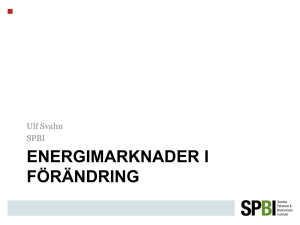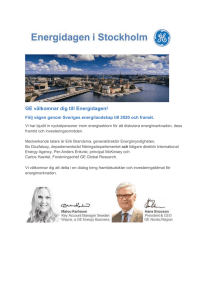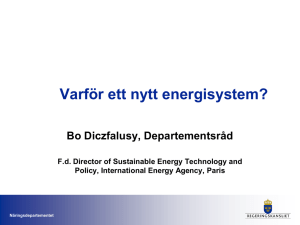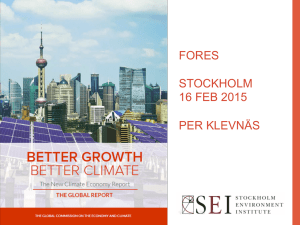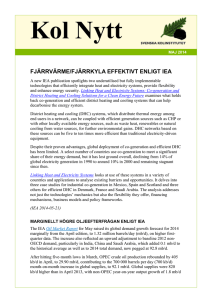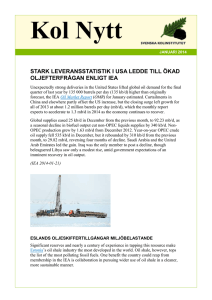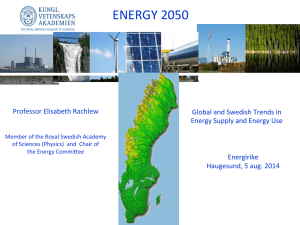framtidens drivmedel och den globala utvecklingen av
advertisement
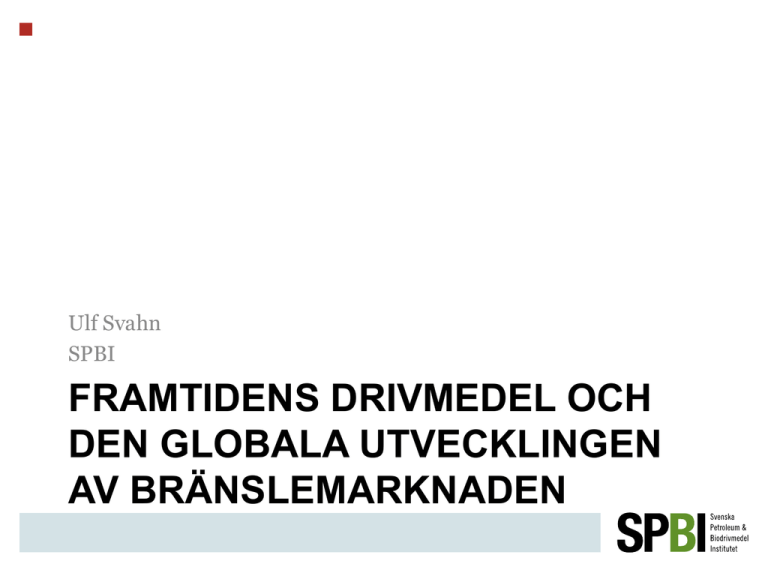
Ulf Svahn SPBI FRAMTIDENS DRIVMEDEL OCH DEN GLOBALA UTVECKLINGEN AV BRÄNSLEMARKNADEN WEC Simply put, the World Energy Council (WEC) is the largest global network of energy leaders and practitioners dedicated to delivering a sustainable energy system for the greatest benefit of all. Originally intended as an organisation to manage a gathering of energy experts, the WEC has evolved into one of the world’s most influential energy organisations. WEC Simply put, the World Energy Council (WEC) is the largest global network of energy leaders and practitioners dedicated to delivering a sustainable energy system for the greatest benefit of all. Originally intended as an organisation to manage a gathering of energy experts, the WEC has evolved into one of the world’s most influential energy organisations. Securing tomorrows energy today Myt 1 Myth 1: Global energy demand will flatten out Källa: WEC Primärenergianvändning Energiintensitet Källa: IEA WEO 2013 Myt 1 Myth 1: Global energy demand will flatten out The Reality: Energy demand will continue to increase and double by 2050, primarily driven by economic growth in non-OECD countries. Källa: WEC Myt 2 Myth 2: Peak Oil – there is an imminent shortage of fossil fuel resources Källa: WEC Hubberts kurva Hubberts kurva Källa: EIA Hubberts kurva Källa: EIA Globala fossila resurser Fossila resurser är ändliga Fossilt energifönster Källa: IEA WEO 2013 Globala fossila utvinningsbara resurser 2 670 miljarder fat konventionell olja inkl. NGL 345 miljarder fat LTO 1 880 miljarder fat extra tung bitumen olja 790 miljarder fat behöver utvinnas för att möta till 2035 Fossila resurser är efterfrågan ändliga Fossilt energifönster Källa: IEA WEO 2013 Tillgångar proved reserves 1992 – 2012 olja Konsumtion 1992 – 2002 ca 290 tusen miljoner fat Konsumtion 2002 – 2012 ca 370 tusen miljoner fat Konsumtion 1965 – 2012 ca 1 170 tusen miljoner fat Källa: BP statistical review, Earth Policy Institute Totala tillgångar konventionella råoljor “Resources on this scale are more than sufficient to meet the projected demand for conventional crude oil to 2035, even given the uncertainties over the size of reserves growth and undiscovered oil.” Källa: IEA WEO 2013 Fördelning av utvinningen mellan kategorierna Andelen okonventionella resurser av totalt producerat var 10 % 1990 12 % 2000 och 20 % 2012 – prognos 1/3 del 2035 NGL: s 14,5 % och 5,5 % Bitumen, oljesand och skifferolja Källa: IEA WEO 2013 Myt 2 Myth 2: Peak Oil – there is an imminent shortage of fossil fuel resources The Reality: There is no shortage in sight. The continued discovery of new resources and the emergence of new technologies that both enable the release of unconventional oil and gas and improve the recovery rates from existing fields have already multiplied the available fossil fuel reserves by a factor of four, and this trend will continue. Källa: WEC Myt 3 Myth 3: Demand growth will be fully met by the new clean energy sources Källa: WEC Global energiutveckling – per energislag Fossil dominans utan nya åtgärder Oljan fortfarande störst men minskar sin relativa andel Förnybart ökar mest – från låg nivå Naturgas kraftig tillväxt – CO2-koppling Källa: IEA WEO 2013 Global efterfråga olja till 2035 Asien dominerar India växer snabbare än Kina från 2020 Källa: IEA WEO 2013 Oljeanvändning globalt New Policy Scenario Current Policy Scenario 450 policy scenario Transportsektorns andel 2035 60 % - 52 % 2011 60 mbd Källa: IEA WEO 2012 Fracking teknologin Bild: Lifetransplanet Global produktion LTO Källa: IEA WEO 2013 Biodrivmedel global utveckling Brasilien nettoexportör över tid Etanol dominerar Andel okonventionella produkter 2035 - 20 % Andelen el i transportsektorn 2 % 2035 Källa: IEA WEO 2013, 2011 Myt 3 Myth 3: Demand growth will be fully met by the new clean energy sources The Reality: WEC analysis in the World Energy Scenarios shows that despite significant growth in the relative contribution of renewables from 15% today to a figure between 20% and 30% in 2050, in absolute terms the volume of fossil fuels used to meet global energy demand will be 16,000 MTOE in the Jazz (the more consumerdriven scenario) and 10,000 MTOE in Symphony (the more voter-driven scenario), compared to 10,400 MTOE in 2010. This represents a 5% decrease in the absolute amount of fossil fuels in Symphony but a 55% increase in Jazz. Källa: WEC Myt 4 Myth 4: We can reduce global GHG emissions by 50% by 2050 Källa: WEC Drivmedelsutveckling - väg - globalt IEA New Policy Scenario Energibehovet ökar med 1,3 % per år Andelen fossila drivmedel ca 90 % 2035 Fortsatt dieseltrend 31 mbd 2035 Vätgas och fuel cell? Naturgas framför allt inom tung transport - Sjöfart Biodrivmedel 8 % 2035 Evolution eller revolution Källa: IEA WEO 2013 Fordonsutveckling globalt Personbilar Lastbilar 2011 740 000 000 310 000 000 2035 2 100 000 000 850 000 000 2050 (linjär uppräkning) 2 800 000 000 1 200 000 000 Källa: Bil Sweden IEA WEO 2013 Framtida Drivmedel Bensin Diesel Flygfotogen Flygbensin Bunkerolja Gasol Naturgas CNG LNG Biogas CNG Dimetyleter Etanol FAME HVO Syntetisk diesel El Metanol Fossil/ Förnybar Fossil/ Förnybar Fossil/ Förnybar Fossil Fossil Fossil Fossil Förnybar Förnybar/Fossil Förnybar/Fossil Förnybar/Fossil Förnybar Förnybar/Fossil Förnybar/Fossil Förnybar/Fossil Personbilsflottan Sverige Jan 2013 Bensinbilar 3 200 000 Dieselbilar 925 000 Flexi fuel bilar Etanol/Bensin 225 000 Flexi fuel bilar Gas/Bensin 36 000 Elhybrider/El 24 000 Källa: Bilismen i Sverige 2013, SPBI bearbetning Personbilsflottan Sverige Jan 2013 3 200 000 • Bensinbilar Ett bränsle måste kunna tas emot av fordonen 925 000 • Dieselbilar Genomsnittslivslängden på ett personfordon är 17 år Flexi fuel bilar Etanol/Bensin 225 000 • Politikens inriktning 2030 - 2050 Flexi fuel bilar Gas/Bensin 000 • Ett ökat antal36drivmedel kombinerat med sjunkande volymer försvårande Elhybrider/El 24 000 Källa: Bilismen i Sverige 2013, SPBI bearbetning Myt 4 Myth 4: We can reduce global GHG emissions by 50% by 2050 The Reality: According to the WEC’s World Energy Scenarios, even in the best case we will see a near doubling of global greenhouse gas (GHG) emissions by 2050, compared to where we should be in 2050 to meet the 450 parts per million CO2 reference adopted by many. At worst GHG emissions could increase by over four-fold. Källa: WEC Myt 5 Myth 5: Current business models and markets are delivering Källa: WEC Prisjämförelse diesel FAME i dieselekvivalenter Källa: Argus SPBI bearbetning Prisjämförelse bensin etanol i bensinekvivalenter Kr/l Källa: F. H. Licht SPBI bearbetning Myt 5 Myth 5: Current business models and markets are delivering The Reality: WEC analysis shows that energy markets are become increasingly complex, driven by accelerated change in energy policy, technological innovation, and consumer expectations. Current market designs and business models are unable to cope with the increasing renewable shares, decentralised systems, or growing information architecture. Källa: WEC Myt 6 Myth 6: Current programs will deliver universal access to energy within the next 10 to 15 years The Reality: Universal access is far from becoming a reality. While acknowledging recent progress and current programs to reduce energy poverty, the WEC’s analysis shows that on current paths, between 730 million and 880 million people for Jazz and Symphony respectively will still be without access to electricity in 2030 and between 320 million and 530 million people in 2050 globally. Källa: WEC Myt 7 Myth 7: On a global scale capital is cheap and abundant The Reality: Capital is extremely sensitive to perceived political and regulatory risks. Moreover, due to the growing pressures on public finances in most countries, public funds will not be available to substitute or augment the private financing of energy initiatives. Källa: WEC Sammanfattning • Globalt ökat energibehov • Globalt dominerar oljan transportsektorn i årtionden framöver • Effektivisering och elektrifiering viktig • Förnybara bränslen kommer att öka • Etanol dominerar – HVO – annan biokomponentproduktion • Konventionella förnybara drivmedel dominerar okonventionella ökar • Nya bränslen med nya logistikkrav har en introduktionsbarriär • Förnybara drivmedel dyrare än fossila – Behov av styrmedel • Europa i otakt med resten av världen • Europa i otakt internt Tack för intresset www.spbi.se ulf.svahn@spbi.se
